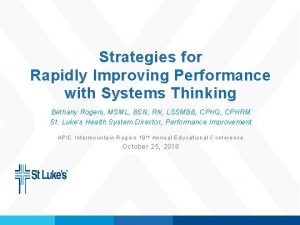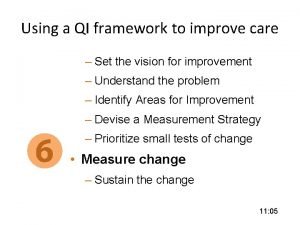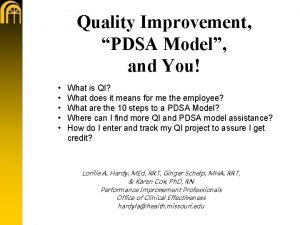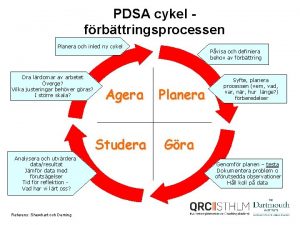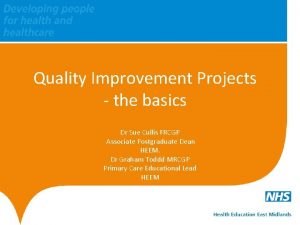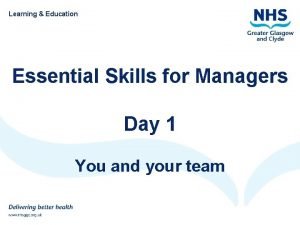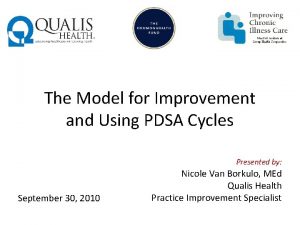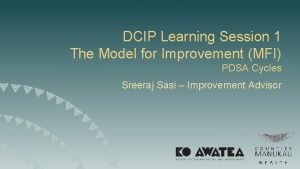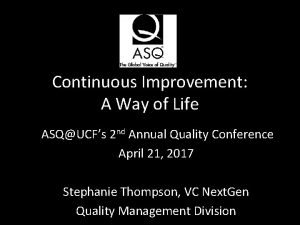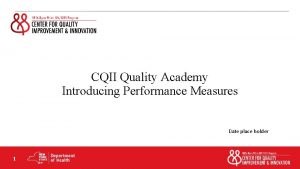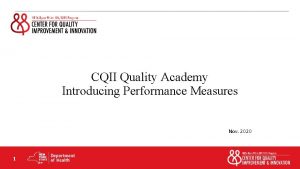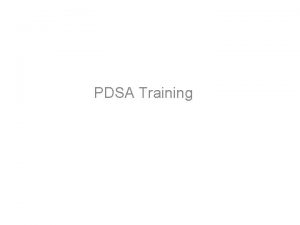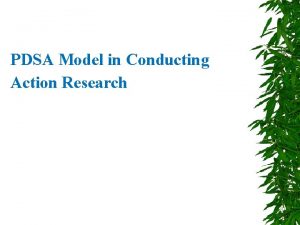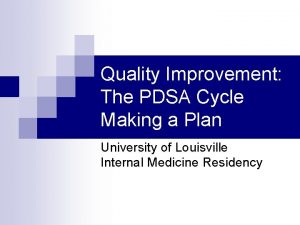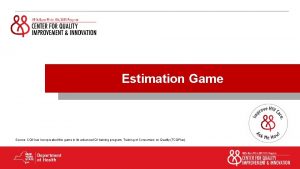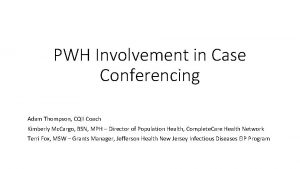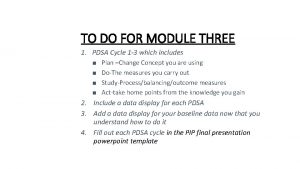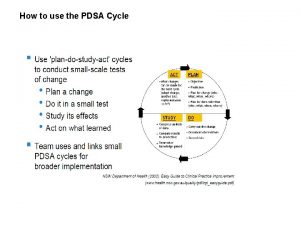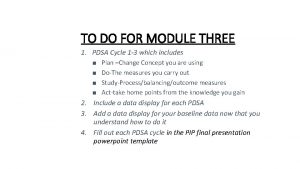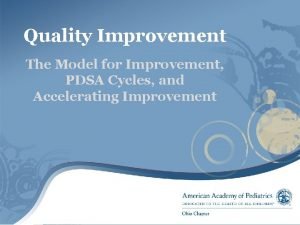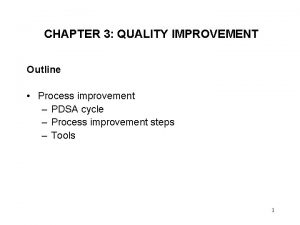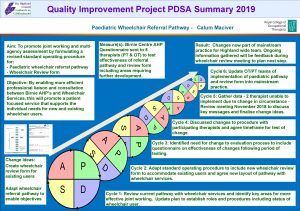CQII Quality Academy The PDSA Cycle 1 Lets



























- Slides: 27

CQII Quality Academy The PDSA Cycle 1

Let’s Review • So far, we have discussed: • Performance measurement and its importance • Data as the key in knowing what to improve • The Model for Improvement and its three steps • This gives us a structured methodology • We use different techniques to finalize an idea for improvement • And today we will go over… 22

Learning Objectives Today we will give you a better understanding of: • The steps in the PDSA Cycle • How you learn from theory and prediction • How to start a PDSA Cycle • The importance of a plan with clear objectives and staff roles and commitments • How your data help you tweak and improve your plan 33

Introducing the PDSA Cycle AKA The Deming Wheel The PDSA Cycle, designed to test a change, was first introduced to W. Edwards Deming by his mentor, Walter Shewhart of Bell Laboratories in New York. Deming amended the Shewhart Cycle and replaced Check with Study. He felt it made individuals look more deeply at their data. 44

Why Do We Use PDSA Methodology? Why Do We Need To Test Change? • To increase your belief that a change will result in an improvement • To evaluate how much improvement can be expected from the change • To decide if the change will work in your environment • To evaluate cost, benefits, impact, and unintended consequences • Lessen stakeholder resistance by starting small and proving the concept 55

Understanding the PDSA Cycles • The PDSA Cycles start with small tests and ramps up to bigger tests • After each test, see if your result matches your hypothesis • Implement another test based on the results of the prior test • If successful, increase the number of clients or days or providers, or whatever is needed to expand the scope of the test • If not successful, tweak your test and try again with a small sample • Don’t be afraid to abandon the idea if continuous testing doesn’t match the hypothesis • Each test of the change helps to improve your ability to reach your goal by adjusting the intervention according to what you learned 6 10

Step 1: PLAN • State the objective of the test • Choose the team and clarify roles: Who will do what, when, why and where • Your hypothesis makes a prediction about what will happen (ours was: If we lower the no-show rates, then our viral suppression will increase) • Determine your first test population – start small • Develop your step measures • Step measures give you an indication of the accuracy of your hypothesis • They provide structure to make sure you’re accurately measuring the test • You collect data on them in the Do Cycle so you can compare the test result to the hypothesis • Document each test – leave an audit trail for this project and a teaching aid for future projects 7 11

PLAN Cycle Example Decreasing the “No Show” Rate Our Data Analysis, Root Cause Analysis, Brainstorming, and Force Field Analysis have led us to the hypothesis that implementing an Uber contract for client transportation will decrease the “No Show” rate from the current 30% to 10% • Hypothesis: If we do this, then this will happen • We have brought more specificity to our hypothesis 8 12

PLAN Cycle Example Decreasing the “No Show” Rate The plan for the first cycle is: • One Case Manger will arrange the transportation for clients with the highest “Noshow” rates • The number of missed appointments will be documented • The client’s satisfaction with the service will be documented • The first cycle will include one client with an appointment on one day, who has already missed 2 appointments in a row due to lack of transportation • We choose one client to start • The receptionist will collect the data 9 13

Let’s Examine The Plan and Review • You analyzed data • You set step measures: • The number of missed appointments will be documented • The client’s satisfaction with the service will be documented • You started small (one client, one day) • You have the infrastructure in place 10 14

Step 2: DO • Carry out your plan • Collect data on your step measures • Make sure the data are directly related the hypothesis • Use a standardized data collection tool • Check sheet • Excel • Documenting steps as a permanent record of your activities • It acts as a road map for future tests • It’s a training tool for staff now and in the future; turn over negatively affects quality • Note anything unexpected that happened 11 15

DO Example • Case Manager arranges the Uber pick up for the one client • Receptionist notes that the client did not miss the appointment • Client satisfaction with service was logged • No barriers were noted, nothing unexpected happened • The check sheet may look like this: 12 16 Pt Id Pt. presented Pt. saw prescriber Pt satisfaction rating 1 = Bad/5 = good 12345 Yes or no 4 comments

Step 3: STUDY • Analyze the data collected by your step measures • Compare your data to your hypothesis • Did the test work as predicted? • Did the data match or come close to the hypothesis? • Summarize and reflect on what you learned 13 17

Step 3: STUDY Example • The cycle was implemented with one client and the plan worked as predicted • The step measures showed: • The client indicates satisfaction with the service • The client made the appointment • Feedback from the case manager and receptionist indicates that expanding the scope of the test as is, would be advised Continue 14 18

Study Cycle Summary • We analyzed the data • We see that we achieved the result we thought we would • We received input from the team • We then proceed to the Act Cycle 15 19

Step 4: ACT • Your action should depend on what you learned • Should you expand the scope of the test for the next cycle? • Do you need to modify the intervention and retest a small sample? • After a few tests, decide if: • You should abandon if no test seems to support the hypothesis • Rethink the hypothesis if inconclusive • Share your results and get feedback and input from your quality improvement teammates 16 20

Step 4: ACT Example • The results of the first test are shared with the team • The team decides to expand the test to 3 other clients who are chronic noshows • Enter the Plan phase for Cycle 2 Continue 17 21

Act Cycle Summary • This is where you apply your analysis and observation • If you are satisfied with the result, you expand the test • If you are not satisfied with the result, you may consider tweaking it • In this phase, you conceptualize the next test • How many clients involved • The staff member(s) involved in testing • Move on to the next cycle 18 22

Plan Cycle 2: Three Clients PDSA Cycle Step Action Plan Expand test to 3 additional clients Do Case Manager contacts 3 clients with upcoming appointments and arranges their Uber transportation Study > Receptionist documents that 2 clients arrived and departed as planned > One client was not available for pick up > Follow up indicates that 2 clients were satisfied with the service and 1 client was waiting for pick up at a different address > Case Manager notes that the agency had to pay for all 3 rides Act > Case manager adds an updated address check before arranging rides, to her To Do list > Case manager advises a small increase in test scope 19 23

Cycle 3: Five clients PDSA Cycle Step Action Plan Case Manager confirms current addresses and arranges Uber rides for 5 clients with appointments in the first 2 weeks of May Do Four clients arrive on time and 3 arrived at home at the prescribed time. One client cancels appointment the day of appointment Study > Three clients express satisfaction, 1 client expresses frustration with Uber delay going home. Driver got caught in the Cinco De Mayo parade traffic > Receptionist did not make Case Manager aware of the cancellation, so agency had to pay for that ride Act > Test not matching the hypothesis > Case manager calls a team meeting before entering next cycle Continue 20 24

Time for a Team Meeting • Case Manager expresses frustration at the amount of work involved • Requests that clients be able to schedule their own rides • Due to possibility of abusing Uber Health rides and charges, the team denies the request • Receptionist offers to schedule rides. Since she already handles the cancelations, she will be the point person for ride schedules • Receptionist will add the Uber information when the standard client appointment reminders go out • Receptionist will coordinate with Case Manager, and Case Manager will to continue to document success and failure of rides as well as client satisfaction 21 25

Cycle 4: Repeat with 5 New Clients PDSA Cycle Step Action Plan > The team plans to pick 5 new clients > Receptionists schedules 5 rides for clients for the following Monday Do > Reminders that include the Uber Health info are communicated to the client two days prior to appointment > Pick up addresses are confirmed by receptionist Study > Four clients arrive and depart on time, one client cancels appointment > Four clients express satisfaction with the service > Fifth client pick was able to be cancelled, so no charges to the agency for that client Act Expand test to all clients who are chronic no-shows for the following week who need transportation 22 26

Summary • Small tests are necessary to test the idea • If the idea works in a small test expand the test • If the idea isn’t supporting the hypothesis; decide to review the data and test a new idea, tweak the current idea or abandon your hypothesis • If an idea is fully implemented without testing, the results could harm the operation of an organization • Imagine the confusion if there were dozens of chronic no-show clients now getting Uber Health rides • Imagine the task of tracking all these clients • In our model project, we saw: • Inconsistent early results • Frustration by the case manager • Changes to our test • Receptionist takes on more coordination responsibilities • Communication was approved; cancelled appointment coordination improved 23 27

Summary • We made adjustments as necessary • Our repeated tests gave us increase confidence in our change idea • The quality improvement project team worked together to analyze the data and keep the focus on the project • PDSA Cycles are iterative; never claim success or failure after one test 24 28

Resources • PDSA Cycles https: //www. youtube. com/watch? v=g. Eb. V 1 yg 0 Lw. U • PDSA Cycle worksheet https: //targethiv. org/library/mfipdsa-worksheet • Foundation and History of the PDSA Cycle https: //deming. org/uploads/paper/PDSA_History_Ron_Moen. pdf • Request CQII technical assistance https: //targethiv. org/cqm-ta-request 25 29

To view the presentation, go to: https: //youtu. be/t. JSB 5 Gesa. WA 26

Properties On passing, 'Finish' button: Goes to next slide On failing, 'Finish' button: Goes to next slide Allow user to leave quiz: After user has completed quiz User may view slides after quiz: Any time Show quiz in menu as: Edit in Quizmaker Multiple Items Edit Properties
 Model for improvement
Model for improvement Pdsa cycle in healthcare
Pdsa cycle in healthcare Pdsa worksheet
Pdsa worksheet Manfaat pdsa
Manfaat pdsa Rampa de pdsa
Rampa de pdsa Pdsa template
Pdsa template Pdsa cykel
Pdsa cykel Jens bejer damgaard
Jens bejer damgaard Pdsa model nhs
Pdsa model nhs Pdsa model nhs
Pdsa model nhs Pdsa sirkel
Pdsa sirkel Diagrama direcionador
Diagrama direcionador Pdsa sirkel
Pdsa sirkel Pdsa
Pdsa Pdsa falkirk
Pdsa falkirk Pdsa
Pdsa Ucf pdsa
Ucf pdsa Quality assurance vs quality control
Quality assurance vs quality control Pmp quality vs grade
Pmp quality vs grade Pmbok quality assurance vs quality control
Pmbok quality assurance vs quality control Quality assurance model in nursing management
Quality assurance model in nursing management Compliance vs quality
Compliance vs quality Quality control basics
Quality control basics David a garvin 8 dimensions of quality
David a garvin 8 dimensions of quality Crosby's fourteen steps to quality improvement
Crosby's fourteen steps to quality improvement What is tqm
What is tqm Hình ảnh bộ gõ cơ thể búng tay
Hình ảnh bộ gõ cơ thể búng tay

